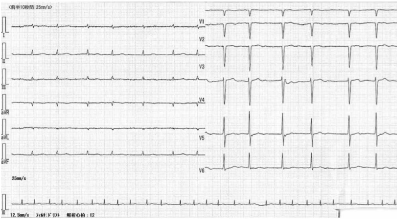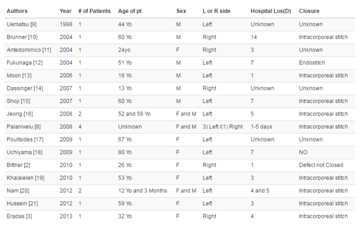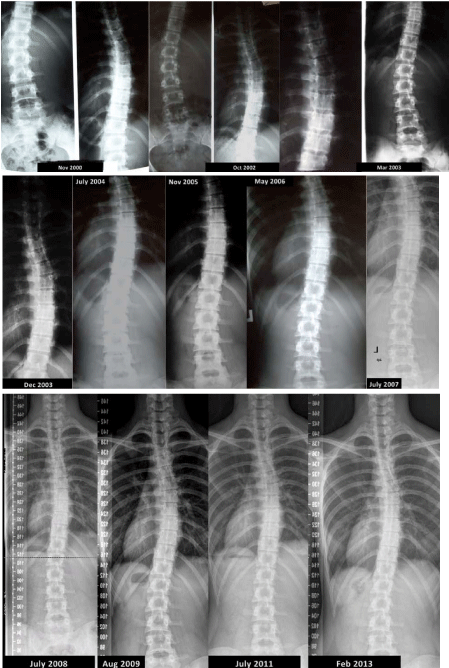Case Report
Conservative Treatment of Idiopathic Scoliosis- A Case in Long-Term Follow-up
Wnuk B*, Dzierżęga J and Durmała J
Department of Rehabilitation, Medical University of Silesia in Katowice, Poland
*Corresponding author: Bartosz Wnuk, Department of Rehabilitation, School of Health Sciences in Katowice, Medical University of Silesia in Katowice, Poland
Published: 27 Jun, 2016
Cite this article as: Wnuk B, Dzierżęga J, Durmała J.
Conservative Treatment of Idiopathic
Scoliosis- A Case in Long-Term Followup.
Ann Clin Case Rep. 2016; 1: 1033.
Abstract
Aim: Retrospective assessment of the conservative brace and improvement treatment effectiveness,
on the selected example of a person with adolescent idiopathic scoliosis.
Case: The study was conducted basing on a documentation review from the latest 13 years of the
patient’s diagnosed with two arc scoliosis (AIS): right-sided chest (primary curve, Cobb angle = 33˚,
AVR = 5), left-sided lumbar (secondary curve, Cobb angle = 21˚, AVR = 10). Within 11 years, we
used both systematic brace and improved treatment (Cheneau Brace) with the use of the active three
dimensional curvature correction (DoboMed' Method).
Results: Over the period of 13 years of observation we have recorded improvement in the majority
of variables in radiological examination. The curvature angle of the thoracic spine decreased by 12°,
in the lumbar region of 9° in comparison to initial value. In the parameters of the spine axial rotation
was observed rotation reduction by 3° in the thoracic and decrease in the lumbar region by 2° has
been observed.
Conclusion: Conservative treatment according to the methods recommended by the society
SOSORT reduces the risk of scoliosis progressive development. For the positive effects of the
treatment is both the systematic treatment and support from the family of the patient are extremely
important.
Introduction
Adolescent idiopathic scoliosis is a three dimensional deformation of the spine, which causes a change in the symetry of posture. In the transverse plane the vertebrae rotation and the thoracic influences the formation of the rib projection on the convex curvature side [1]. The corrective impact focused on vertebrae peak derotation, increasing the ribs mobility on the concave curvature side has the basic importance in the conservative treatment of idiopathic spinal curvatures and respiratory disorders associated with them [2-4]. The aim of the publication is to present the history of patients with juvenile idiopathic scoliosis, treated conservatively both with specific kind of physiotherapy and brace. The presented case is a person who has already completed conservative treatment of scoliosis.
Case Presentation
Patient
JB (girl) was born in November 1988. Scoliosis was diagnozed exactly in 12 years old patient
(November 2000). Earlie in her family doctors also diagnosed scoliosis at her mother and aunt.
The patient’s menarche was at the age of 11, a few months before the diagnosis of scoliosis. Within
two years, was observation conducted and was a used physiotherapeutic scoliosis specific exercise
(PSSE). The patient from November 2002 began to apply corrective brace - Cheneau type. At the age
of 16 they started to use specific physiotherapy using DoboMed’ method.
The patient was hospitalized eight times (2004-2009, 2011, 2013), to apply a stationary intensive
rehabilitation (SIR). At that time the following variables were recorded: kyphois, lordosis, the angle
of trunk rotation, weight, height, (Table 1). In the posture study she was monitored, throughout
the period of treatment, using the same method of measurement, the thoracic kyphosis and lumbar
lordosis values (V-Plurimeter) and the trunk rotation values measured by scoliometer [5,6]. There
is no reliable data on the frequency of wearing a brace 2002-2004. Probably the brace was worn for
8-12 hours daily. Since 2004, the brace was between used 14-16 hours a day, and physiotherapy 1-3
times a week. In the period between 2005 and 2008, the brace has been used approx. 12 hours a day.
Since 2009, they began to withdraw the brace, limiting its use only for the night, and exercise once a week. In 2011, they discontinued the use of the brace and exercises were upheld. Exercises were applied three times a week. In 2013, they finally completed the treatment.
Treatment
Corrective brace - Cheneau type: The Cheneau brace is the most widely used in Europe. It is preferable to use the orthosis curvature of the spine between 20 and 45 degrees. The Cheneau brace creates pressure on the convexity of the curve, and, on the opposite side are wide expansion chambers in the frontal, sagittal, and horizontal planes. The Chêneau brace has been found to prevent curve progression and to decrease axial rotation of spine. It is made of thermoplastic material. Each brace is made individually for a patient. This orthosis should be removed only for toileting and physiotherapy process [7,8].
DoboMed: DoboMed method is used in the conservative treatment of idiopathic scoliosis. It is based on the active three dimensional curvature correction in specific symetrical positions output by "asymmetric" respiratory track, which occurs as a result of the chest active mobilization on the side of concave and convex curvature. Activity is focused on vertebral peak curvature height. In the inspiratory phase proprioceptive stimuli is applied to the concave side of the curvature, whereas in the expiratory phase – exteroceptive stimuli to the convex side of the curvature. The patient in each position makes the active correction of posture by a symmetrical adjustment of the shoulder girdle, pelvic girdle, and trunk, as well as the upper and lower limbs. The correction also appears in the sagittal plane by thoracic kyphotisation and determination in the neutral position of the lumbar spine [3,5,9,10]. As a result of "asymmetric" respiratory track, there is a chest mobilization, rib – vertebrate joints mobilization on the side of the concave curvature and the intervertebral joints mobilization, resulting in vertebrae derotation. The therapy of DoboMed method was conducted by certified therapists who had 10 years of experience in clinical work with scoliosis.
Figure 1
Table 1
Figure 2
Discussion
Changes in the X-ray study are shown in (Figure 1). The picture were taken in November 2000 with the recognition, it presented right-sided thoracic scoliosis Cobb 33°, AVR 5 and the left-sided lumbar scoliosis Cobb 21°, AVR 10. At the inclusion brace treatment (October 2002) scoliosis reached the following values Th dex Cobb 38°, AVR 5 and L sin Cobb 25°, AVR 7. Until March 2003 through the use of the brace obtained a slight curvature reduction - Th dex Cobb 26°, AVR 9 and L sin Cobb 22°, AVR 3. Systematicaly conducted conservative treatment succeeded in curvature reduction in July 2008 to the following values - Th dex Cobb 17˚, AVR 14 and L sin Cobb 15°, AVR 4. In the last X-ray picture in February 2013 after the completion of conservative treatment, the following curvature values - Th dex Cobb 21°, AVR 2, and L sin Cobb 12°, AVR 8 have been found. In 2000, 2002 and 2003 for technical reasons it was impossible to perform one long X-ray of all segments of spine. In those years separate images of the lumbar and thoracic spine were made. Although it was necessary to take two pictures of the spine, it was possible to measure the angle of the Cobb. Another limitation of the study was the lack of data on kyphosis and lumbar lordosis values and angle of trunk rotation values in the years 2000 to 2004. Systematic review of interventions gives us interesting information. There is a lack of high-quality evidence to recommend the use of physiotherapeutic scoliosis specific exercises for AIS [11]. However there is evidence of efficacy of Cheneau ‘brace to avoid surgery and reduce the progression of scoliosis [8,12]. In our case, we can see the variability in the measurements of Cobb angles during 13 years. Between 2011 a 2013 the angle of trunk rotation did not change significantly. The given therapy ranges, specific physiotherapy and the use of a brace are the information coming from the history of the patient and her parents. Unfortunately, it was not possible to objectify the patient's cooperation for technical reasons (lack of access at the time of sensors assessing the brace wearing time and pressing force). In spite of the fact that the declarative values showed sometimes a relatively little the involvement of the patient, the total assessment of the cooperation and her commitment to her treatment process lasting 13 years is high. Presented clinical example shows that, despite large loads (family history), and the relatively late start of treatment, using appropriate methods of conservative treatment and cooperation, can be obtained relatively good results of idiopathic scoliosis treatment can be obtained [13,14].
Acknowledgments
We would like to thank Ms. JB for giving consent to provide documentation and execution of research and photographs for publication.
References
- Kotwicki T, Szulc A, Dobosiewicz K, RapaÅ K. The pathomechanism of idiopathic scoliosis: the importance of physiological thoracic kyphosis. Ortop Traumatol Rehabil. 2002; 4: 758-765.
- Dobosiewicz K, Durmala J, Kotwicki T. Dobosiewicz method physiotherapy for idiopathic scoliosis. Stud Health Technol Inform. 2008; 135: 228-236.
- Durmala J, Kotwicki T, Detko E. Physiotherapy for idiopathic scoliosis according to DoboMed. Appendix Physiother. Theory Pract. 2011; 27: 102-105.
- Takahashi S, Suzuki N, Asazuma T, Kono K, Ono T, Toyama Y. Factors of thoracic cage deformity that affect pulmonary function in adolescent idiopathic thoracic scoliosis. Spine (Phila Pa 1976). 2007; 32: 106-112.
- Wnuk B, Frackiewicz J, Durmala J, Czernicki K, Wadolowski K. Short-term effects of combination of several physiotherapy methods on the respiratory function - a case report of adolescent idiopathic scoliosis. Stud Health Technol Inform. 2012; 176: 402-406.
- Negrini S, Aulisa A, Aulisa L, Circo AB, Demauroy J, Durmala J, et al. 2011 SOSORT guidelines: Orthopaedic and Rehabilitation treatment of idiopathic scoliosis during growth. Scoliosis. 2012; 7: 3.
- Kotwicki T, Cheneau J. Biomechanical action of a corrective brace on thoracic idiopathic scoliosis: Cheneau 2000 orthosis. Disabil Rehabil Assist Technol. 2008; 3: 146-153.
- Weiss H, Werkmann M. Rate of surgey in a sample of patients fulfilling the SRS inclusion criteria treated with a Cheneau Brace of actual standard. Stud Health Technol Inform. 2012; 176: 407-410.
- Dobosiewicz K, Durmala J, Czernicki K, Piotrowski J. Radiological results of Dobosiewicz method of three-dimensional treatment of progressive idiopathic scoliosis. Stud Health Technol Inform. 2006; 123: 267-272.
- Dobosiewicz K, Durmala J, Czernicki K. A retrospective analysis (October 1999 - September 2004) of the effects of conservative treatment of in-patients with progressive scoliosis in the Department of Rehabilitation in Katowice. Ann Acad Med Siles. 2007; 61: 1-3.
- Romano M, Minozzi S, Zaina F, Saltikov JB, Chockalingam N, Kotwicki T, et al. Exercises for adolescent idiopathic scoliosis: a Cochrane systematic review. Spine (Phila Pa 1976). 2013; 38: E883-893.
- Fang MQ, Wang C, Xiang GH, Lou C, Tian NF, Xu HZ. Long-term effects of the Chêneau brace on coronal and sagittal alignment in adolescent idiopathic scoliosis. J Neurosurg Spine. 2015; 23: 505-509.
- Fabian KM. Evaluation of lung function, chest mobility, and physical fitness during rehabilitation of scoliotic girls. Ortop Traumatol Rehabil. 2010; 12: 301-309.
- Bettany-Saltikov J, Cook T, Rigo M, Demauroy J, Romano M, Nergini S, et al. Physical therapy for adolescents with idiopathic scoliosis. Bettany-Saltikov J, Paz-Lourido B, Editors. In: Physical therapy perspectives in the 21st century - challenges and possibilities. 2012; 3-40.



